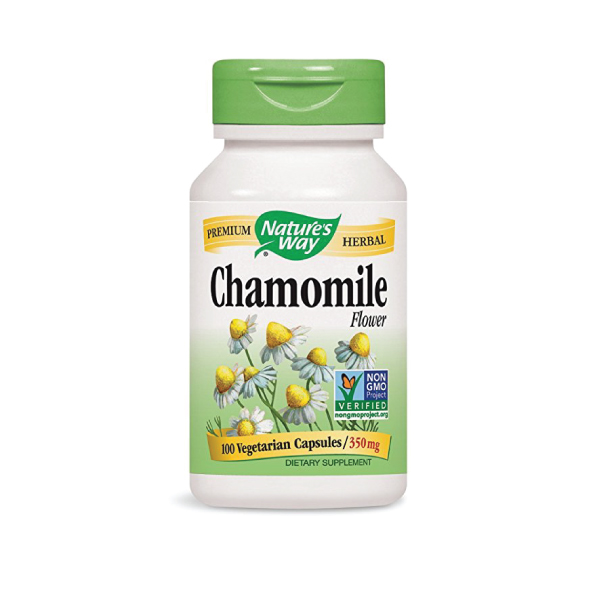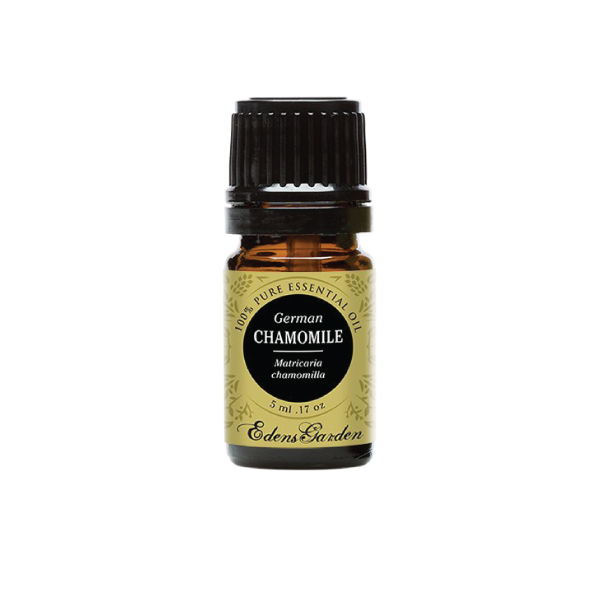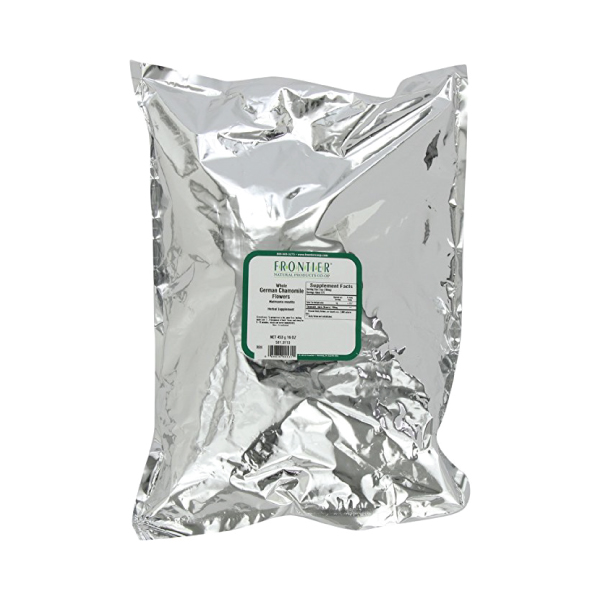What is German Chamomile?
German Chamomile is one of the most commonly used medicinal herb species. this is due to the fact that it has a pleasant flavour and scent, as well as a broad range of medicinal benefits.
This herb can be made into a tea for promoting sleep at night, relieve symptoms of anxiety, and sooth digestive complaints. Additionally, chamomile is used topically in the form of an essential oil, strong infusion, or mixed into salves and creams to treat conditions involving the skin such as burns or wounds.
What Is German Chamomile Used For?
German chamomile is a very well-rounded herb, which is likely the reason it's become so popular all over the world. Unlike many herbs, German chamomile makes a nice cup of tea that can be used as a mild antibacterial for colds and flus, a sedative for insomnia, and as a muscle relaxant.
German chamomile is also useful in topical applications for skin conditions and damage. Common indications include burns, eczema, wounds, boils, and bacterial infections and impetigo.
Traditional Uses of German Chamomile
+ Western Herbal Medicine
Traditionally, Matricaria chamomilla has been used to treat the common cold, bronchitis, gastrointestinal spasms, epilepsy, hypertension, neuralgia, toothache, dysmenorrhea, eczema, impetigo, indigestion, colic, rheumatism, flatulence, diarrhoea, and other digestive disturbances [5, 9]. Externally the flower heads were used to treat skin disorders [9].
Its use was referred to by individuals such as Hippocrates, Galen, and Asclepius and the entire plant including its arial parts, flowers, roots, and volatile oil have all been used medicinally [5]. In modern times, the flowers and volatile oils are generally preferred.
Today, the herb is generally consumed as a tea internally, and its essential oil is mainly used in cosmetics [9].
+ Traditional Chinese Medicine
In TCM, German chamomile is considered to promote the free flow of Qi. This explains the ability for German chamomile to relax the nerves, relieve spasms, and reduce or ease general pain [9].
Herb Details: German Chamomile
Herbal Actions:
- Antinflammatory
- Anti-diarrhea
- Antispasmodic
- Antiallergic
- Antiphlogistic
- Antibacterial
- Carminative
- Diaphoretic
- Mild Astrigent
- Mild Bitter
- Stomachic
- Vulnerary
- Cholagogue
- Choleretic
Weekly Dose
- (1:2 Liquid Extract)
20-40 mL - View Dosage Chart
Part Used
Flowers, essential oil
Family Name
Asteraceae
Distribution
Central & Northern Europe
Constituents of Interest
- Alpha-Bisabolol
- Chamazulene
- Sesquiterpene lactones
- Flavonoids
Common Names
- German Chamomile
- Blue Chamomile
- Hungarian Chamomile
- Kamilla
- Scented Mayweed
CYP450
- Unkown
Quality
- Unknown
Pregnancy
- Safe during pregnancy in small amounts.
Taste
- Unkown
Duration of Use
- Unknown
Products Containing German Chamomile
Botanical Information
Chamomile is a member of the Asteraceae family of plants. This family is very large, consisting of roughly 33,000 species distributed into 1911 genera.
German Chamomile shouldn't be confused with Roman Chamomile (Chamaemelum nobile). Although contained in the same family, and look very similar, the chemical compositions of these plants is very different.
Harvesting Collection, and Preparation
The essential oil of german chamomile is obtained by steam distilling the dried flower heads. This essential oil is contained in the highest amounts in the flowers during the beginning of flowering [9].
Drying the flowers at 40-45C is suggested to preserve the matricarin the most, and as such will result in the highest quality essential oil [9].
Pharmacology & Medical Research
+ Antimicrobial
Matricaria chamomilla has been shown to exhibit both antibacterial, and anti fungal actions in the past, however one recent study [1] found that it had very little antimicrobial action. They suggested that this was due to the low alpha-Bisabolol content in the essential oil (4.14%) as compared to other studies which have noted a significant antimicrobial (especially anti fungal) action which used samples with high alpha-bisabolol content (56.86%) [2].
This leads to the suggestion that this chemical (alpha-Biasabolol) may be the significant antimicrobial constituent of Matricaria chamomilla, which appears to vary greatly depending on either location it was grown, time of the year it was picked, or a combination of both.
+ Diarrhea
Matricaria chamomilla was found to possess antidiarrheal actions in mice, and was determined to be through K+ channel activation as well as through a weak Ca++ channel antagonism [5]. This mechanism of action on reducing spasmodic activity of the gut may provide evidence for its ability to treat other hyperactive disorders of the GIT such as colic as well.
+ Inflammation
Pharmacological investigations have determined anti-inflammatory effects in Matricaria chamomila [6]. The essential oil specifically has also been shown to produce antinflammatory actions when applied topically as well [10, 11].
It is generally accepted that the majority of the anti-inflammatory actions of German chamomile is due to the blue coloured constituent chamazulene. This chemical is formed during heat distillation from the chemical matricarin [9]. Another important anti-inflamatory constituent of German chamomile is alpha-bisabalol, especially for arthritis inflammation [12].
+ Antispasmodic
German chamomile was found to possess antispasmodic actions, mediated through K+ channel activation, and weak Ca++ antagonist effects [5]. This study has been supported by other pharmacological investigations of a similar species M. recutata as well [7].
+ Insomnia
Apigenin, contained in German chamomile, as well as other herbs from the Asteraceae family, have been found to possess anxiolytic actions in lab studies [3]. This flavonoid acts via the GABA receptor modulation, which is a common mechanism for many hypnotics as well [4].
Phytochemistry
Constituent List:
- Flavonoids
- Sesquiterpene lactones
- Mucilage
- Choline
- Tannins
- Polysaccharides
- Fatty acids
- Phenolic acids
- Coumarins
- Flavone glycosides (~8%)
- Essential oil (Percentages of essential oil content) [1]
- trans-beta-Farnesene (6.95%)
- (z,z)-alpha-Farnesene (1%)
- Germacrene B (0.25%)
- beta-Pinene (0.22%)
- 1,3,8-para-Menthatriene (0.27%)
- alpha-Bisabolol oxide B (51.43%) (Major constituent)
- alpha-Bisabolol (4.14%)
- Chamazulene/azulene (17.69%) (Major constituent)
- Limonene (3.3%)
- En-in-dicycloether (10.84%)
- Butanedioyldihydrazide (1.39%)
- alpha-(1-Naphthyl)ethylamine (0.5%)
- Hexadecane (0.23%)
- Dotriacontane (0.75%)
The essential oil of chamomile comes in 4 main chemotypes depending on where it has grown [9]:
Type A:
- Alpha bisabolol oxide B (highest)
- Alpha bisabalol oxide A (second)
- Alpha bisabalol (lowest)
Type B:
- Alpha bisabalol oxide A (highest)
- Alpha bisabolol oxide B (second)
- Alpha bisabalol (lowest)
Type C:
- Alpha bisabalol (highest)
- Alpha bisabolol oxide B (second)
- Alpha bisabalol oxide A (lowest)
Type D:
- Alpha bisabolol oxide B (equal portion)
- Alpha bisabalol oxide A (equal portion)
- Alpha bisabalol (equal portion)
Clinical Applications Of Chamomile:
Chamomile is reliable as a topical anti-inflammatory, and antiseptic for a range of conditions. Internally German Chamomile is useful for conditions involving the central nervous system like insomnia, anxiety, and stress.
Synergy
Possible synergy with lemon balm, liquorice, fennel, and vervain for infant colic.
Recent Blog Posts:
References:
Mekonnen, A., Yitayew, B., Tesema, A., & Taddese, S. (2016). In VitroAntimicrobial Activity of Essential Oil ofThymus schimperi,Matricaria chamomilla,Eucalyptus globulus, andRosmarinus officinalis. International Journal of Microbiology, 2016, 1-8. doi:10.1155/2016/9545693
M. Tolouee, S. Alinezhad, R. Saberi et al., (2010). Effect of Matricaria chamomilla L. flower essential oil on the growth and ultrastructure of Aspergillus niger van Tieghem, International Journal of Food Microbiology, vol. 139, no. 3, pp. 127–133
P. Zanoli, R. Avallone, and M. Baraldi, (2000). Behavioral characterisation of the flavonoids apigenin and chrysin,” Fitoterapia, vol.71, supplement 1, pp. S117–S123
Yurcheshen, M., Seehuus, M., & Pigeon, W. (2015). Updates on Nutraceutical Sleep Therapeutics and Investigational Research. Evidence-Based Complementary and Alternative Medicine, 2015, 1-9. doi:10.1155/2015/105256
Mehmood, M. H., Munir, S., Khalid, U. A., Asrar, M., & Gilani, A. H. (2015). Antidiarrhoeal, antisecretory and antispasmodic activities of Matricaria chamomilla are mediated predominantly through K+-channels activation. BMC Complementary and Alternative Medicine, 15(1). doi:10.1186/s12906-015-0595-6
Mazokopakis EE, Vrentzos GE, Papadakis JA, Babalis DE, Ganotakis ES. (2005). Wild chamomile (Matricaria recutita L) mouthwashes in methotrexate-induced oral mucositis. Phytomedicine. 12:25–7.
Maschi O, Cero ED, Galli GV, Caruso D, Bosisio E, Dell' Agli M. (2008). Inhibition of human cAMP-phosphodiesterase as a mechanism of the spasmolytic effect of Matricaria recutita L. J Agric Food Chem. 56:5015–20.
A Modern Herbal. (1931). Chamomile (german). Retrieved from http://www.botanical.com/botanical/mgmh/c/chammo49.html
Battaglia, S. (2003). The Complete Guide to Aromatherapy (2nd ed.). Brisbane, Australia: The International Centre of Holistic Aromatherapy. (Pg 179-180)
Fleischer AM. (1985). Plant extracts: To accelerate healing and reduce inflammation. Cosmetic Toilet. 100. 147-153
Maiche AG. (1991). Effect of chammomile cream and almond ointment on acute adiation skin reaction. Acta Oncol. 30(3). 395-396.
Jakovlev V, Isaac O, Theimer K, Kunde R. (1979). Pharmacological investigations with compounds of chamomile. New investigations on the antiphlogistic effects of (-)-a-bisabalol and bisabalol oxides. Planta medica. 35. 125-140
Bone, K. (2003). A clinical guide to blending liquid herbs: Herbal formulations for the individual patient. Edinburgh [u.a.: Churchill Livingstone. (Pg. 137-141).














As COVID-19 continues to spread around the world, we’re getting a lot of questions on what the potential role of herbal medicine is during the outbreak. Learn how the virus works and how to limit your chances of transmission.